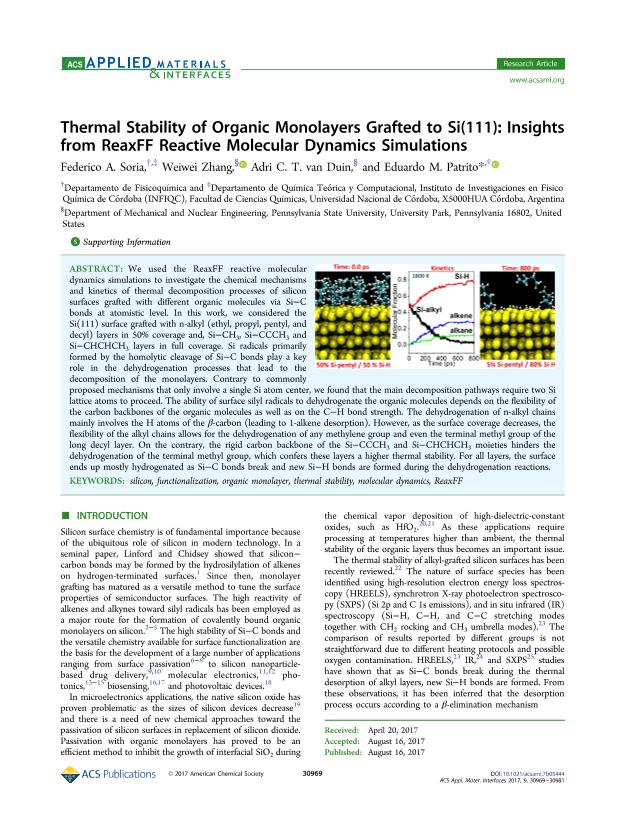Mostrar el registro sencillo del ítem
dc.contributor.author
Soria, Federico Ariel

dc.contributor.author
Zhang, Weiwei
dc.contributor.author
van Duin, Adri
dc.contributor.author
Patrito, Eduardo Martin

dc.date.available
2018-11-08T18:09:37Z
dc.date.issued
2017-09-16
dc.identifier.citation
Soria, Federico Ariel; Zhang, Weiwei; van Duin, Adri; Patrito, Eduardo Martin; Thermal Stability of Organic Monolayers Grafted to Si(111): Insights from ReaxFF Reactive Molecular Dynamics Simulations; American Chemical Society; ACS Applied Materials & Interfaces; 9; 36; 16-9-2017; 30969-30981
dc.identifier.issn
1944-8244
dc.identifier.uri
http://hdl.handle.net/11336/63993
dc.description.abstract
We used the ReaxFF reactive molecular dynamics simulations to investigate the chemical mechanisms and kinetics of thermal decomposition processes of silicon surfaces grafted with different organic molecules via Si-C bonds at atomistic level. In this work, we considered the Si(111) surface grafted with n-alkyl (ethyl, propyl, pentyl, and decyl) layers in 50% coverage and, Si-CH3, Si-CCCH3 and Si-CHCHCH3 layers in full coverage. Si radicals primarily formed by the homolytic cleavage of Si-C bonds play a key role in the dehydrogenation processes that lead to the decomposition of the monolayers. Contrary to commonly proposed mechanisms that only involve a single Si atom center, we found that the main decomposition pathways require two Si lattice atoms to proceed. The ability of surface silyl radicals to dehydrogenate the organic molecules depends on the flexibility of the carbon backbones of the organic molecules as well as on the C-H bond strength. The dehydrogenation of n-alkyl chains mainly involves the H atoms of the β-carbon (leading to 1-alkene desorption). However, as the surface coverage decreases, the flexibility of the alkyl chains allows for the dehydrogenation of any methylene group and even the terminal methyl group of the long decyl layer. On the contrary, the rigid carbon backbone of the Si-CCCH3 and Si-CHCHCH3 moieties hinders the dehydrogenation of the terminal methyl group, which confers these layers a higher thermal stability. For all layers, the surface ends up mostly hydrogenated as Si-C bonds break and new Si-H bonds are formed during the dehydrogenation reactions.
dc.format
application/pdf
dc.language.iso
eng
dc.publisher
American Chemical Society

dc.rights
info:eu-repo/semantics/openAccess
dc.rights.uri
https://creativecommons.org/licenses/by-nc-sa/2.5/ar/
dc.subject
Functionalization
dc.subject
Molecular Dynamics
dc.subject
Organic Monolayer
dc.subject
Reaxff
dc.subject
Silicon
dc.subject
Thermal Stability
dc.subject.classification
Otras Ciencias Químicas

dc.subject.classification
Ciencias Químicas

dc.subject.classification
CIENCIAS NATURALES Y EXACTAS

dc.title
Thermal Stability of Organic Monolayers Grafted to Si(111): Insights from ReaxFF Reactive Molecular Dynamics Simulations
dc.type
info:eu-repo/semantics/article
dc.type
info:ar-repo/semantics/artículo
dc.type
info:eu-repo/semantics/publishedVersion
dc.date.updated
2018-10-22T18:22:19Z
dc.identifier.eissn
1944-8252
dc.journal.volume
9
dc.journal.number
36
dc.journal.pagination
30969-30981
dc.journal.pais
Estados Unidos

dc.journal.ciudad
Washington
dc.description.fil
Fil: Soria, Federico Ariel. Consejo Nacional de Investigaciones Científicas y Técnicas. Centro Científico Tecnológico Conicet - Córdoba. Instituto de Investigaciones en Físico-química de Córdoba. Universidad Nacional de Córdoba. Facultad de Ciencias Químicas. Instituto de Investigaciones en Físico-química de Córdoba; Argentina
dc.description.fil
Fil: Zhang, Weiwei. State University of Pennsylvania; Estados Unidos
dc.description.fil
Fil: van Duin, Adri. State University of Pennsylvania; Estados Unidos
dc.description.fil
Fil: Patrito, Eduardo Martin. Consejo Nacional de Investigaciones Científicas y Técnicas. Centro Científico Tecnológico Conicet - Córdoba. Instituto de Investigaciones en Físico-química de Córdoba. Universidad Nacional de Córdoba. Facultad de Ciencias Químicas. Instituto de Investigaciones en Físico-química de Córdoba; Argentina
dc.journal.title
ACS Applied Materials & Interfaces

dc.relation.alternativeid
info:eu-repo/semantics/altIdentifier/url/http://pubs.acs.org/doi/abs/10.1021/acsami.7b05444
dc.relation.alternativeid
info:eu-repo/semantics/altIdentifier/doi/http://dx.doi.org/10.1021/acsami.7b05444
Archivos asociados
